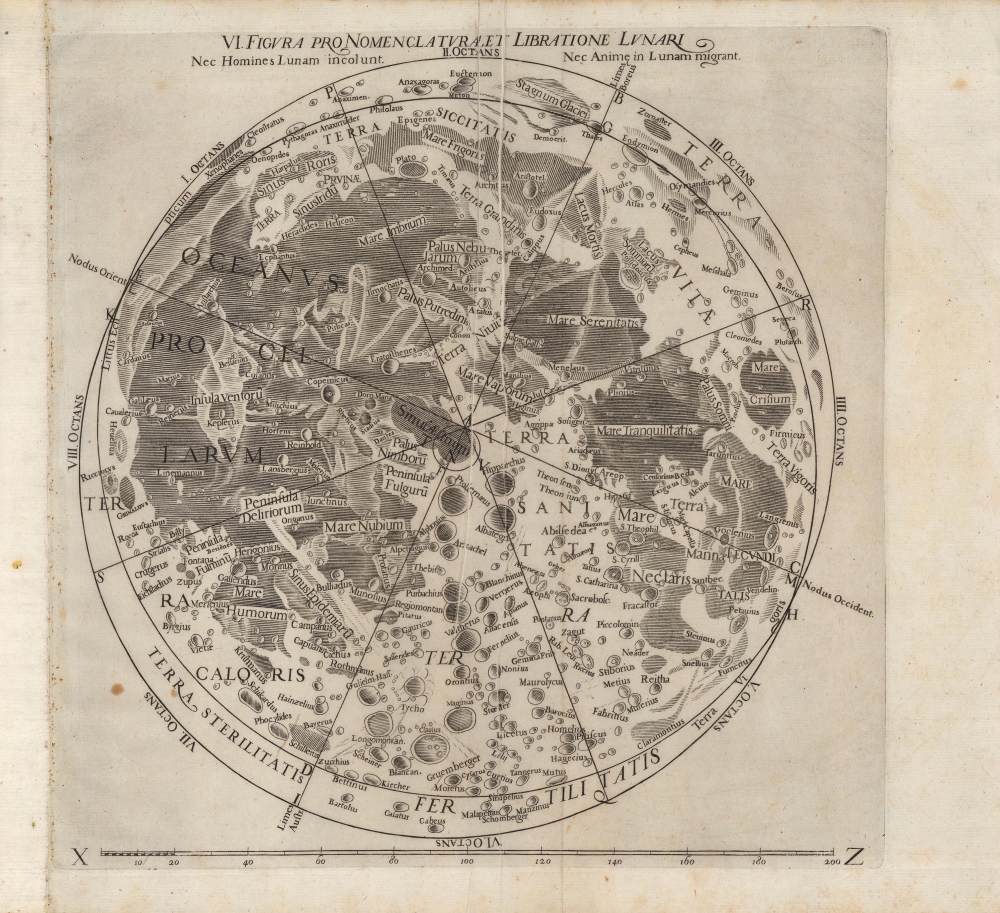This item has been sold, but you can get on the Waitlist to be notified if another example becomes available, or purchase a digital scan.
1665 Riccioli / Grimaldi Map of the Moon
MoonMap-riccioli-1665
Title
1665 (undated) 12.75 x 12.75 in (32.385 x 32.385 cm)
Description
A Closer Look
The major features of the near side of the moon are illustrated, including craters, maria, and mountains. The large and distinctive Oceanus Procellarum sits at left. Riccioli divides the moon's surface into quadrants - noting the Nodus Occident, Nodus Orient, Limes Boreus, and Limes Australis - and then into eighths (octans). The names of features are either descriptive or honorific, in the latter case referring to ancient thinkers (Plutarch, Seneca) or contemporary natural philosophers. At left are two craters named for Riccioli and Grimaldi themselves.Early Selenography
Despite his dogged commitment to geocentrism, Riccioli was one of the most important astronomers of his day, engaging with the theories of Galileo, Kepler, and others. His selenographic work, undertaken with fellow Jesuit Francesco Maria Grimaldi (1618 - 1663), has been especially enduring. The two combined existing knowledge about the moon's surface and developed a standard nomenclature for craters, maria, and other features which largely remains in use today.Publication History and Census
This map was drawn by Francesco Maria Grimaldi and appeared in Giovanni Battista Riccioli's book Astronomia Reformata, published in Bologna in 1665 by the Heirs of Vittorio Benacci. It is an updated edition of a map of the same title that appeared in Riccioli's earlier work, Almagestum Novum. This edition of the map is not independently cataloged among the holdings of any institution, while the entire Astronomia Reformata is held by some twenty institutions worldwide, mostly in continental Europe.CartographerS
Giovanni Battista Riccioli (April 17, 1598 - June 25, 1671) was a Jesuit priest and astronomer active in Italy and Bologna during the early 17th century. Riccioli is most famous as the first person to accurately measure the rate of acceleration of a free falling body. However, his most substantial work is the Lunar measurement and mapping that he completed with Francesco Maria Grimaldi. Riccioli and Grimaldi's map of the moon established many of the planetary and lunar mapping conventions that are still in effect today including the nomenclature for most lunar topography. As a Jesuit and in much of his work, most specifically the 1651 Almagestum Novum which was written to that purpose, Riccioli expresses a clear rejection of Copernicus's heliocentric theories. Which makes it all the more curious that he chose to name one of the Moon's most prominent craters after the great Astronomer. Perhaps a tacit sympathy for Copernican theory? Riccioli died in Bologna in 1671. More by this mapmaker...
Francesco Maria Grimaldi, SJ (April 2, 1618 - December 18, 1663) was an Italian Jesuit natural philosopher, mathematician, and astronomer. Born and raised in Bologna, Grimaldi went on to teach at the Jesuit college there. With fellow Jesuit Giovanni Battista Riccioli, he undertook important research on gravity and astronomy, among other achievements producing an early and influential selenograph or map of the moon's surface. His experiments with the diffraction of light were also highly important for later scientists. Learn More...

